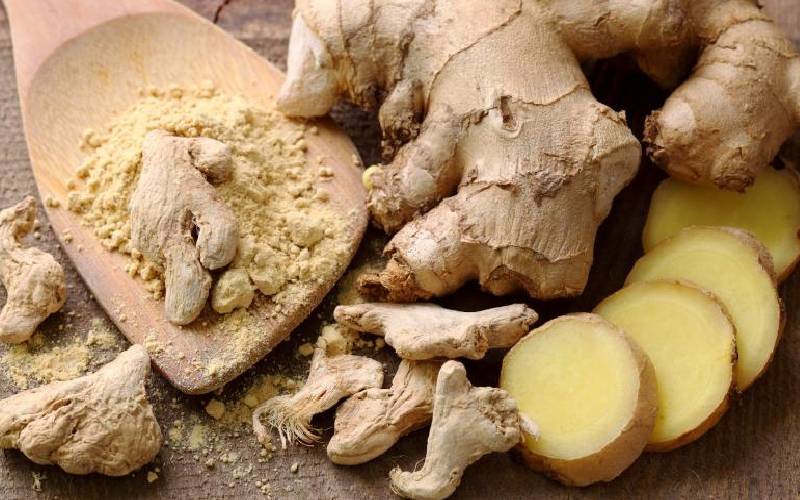The A to Z of growing healthy ginger herb

Growing ginger, though rewarding, requires a lot of patience and hard work. Why? It is a labour intensive operation and takes a lot of time in the field to mature.
As an annual crop, it requires constant attention. Also, it’s highly labour-intensive and most of its processes are manual.
A number of workers are required for harvesting, washing and packing. It can be intercropped with crops such as macadamias, pigeon pea, bananas and sunflower, which can provide some shade to the crop. The easiest way to get started is to simply get a few fresh rhizomes.
You can get some from a farmer who grows ginger, or buy at the local grocery store or market. Make sure you select fresh, plump rhizomes.
Soils
Ginger is adaptable to a wide range of climatic conditions. It thrives best in soils with an alkaline or neutral pH of 5.0-6.5.
Acidic soil reduces the size and shape of the root. The soil should be fertile, well drained loamy. Heavy soils humper the development of smooth rhizomes. Sandy soils leach rapidly and intensifies infestation of nematodes. Manure should be applied to ensure a healthy crop and optimum yields. Apply fertilisers to boost nutrients in less fertile soils especially during planting.
The crop is sensitive to low temperature as it induces dormancy. High temperatures and intense sunlight, on the other hand, can result in scorching especially in young plants.
To minimise the leaf scotch due to high temperatures, intercrop the crop with a cover crop to provide shade.
Propagation
Ginger is propagated from rhizomes which are selected at harvest, hardened and stored for the next planting season. The rhizome fingers are separated into setts approximately 2.5cm having at least one visible eye, which will give rise to new plant. Planting infected rhizomes can affect the whole farm.
The setts are dipped in fungicide solution to minimise fungal attack and germinated by covering them with moist organic layer of damp sawdust before planting. The germinated setts are planted on ridges and shoots will start appearing 10-15 days after planting.
Phosphate fertilisers are incorporated during planting with nitrogenous and potassium fertilisers being applied as splits. As the plants grow, a heap of soil is put around the plant to create a soft ridge into which ginger grows.
Diseases
Nematodes are the biggest threat to ginger crop. To manage them, practise crop rotation and avoid farms that previously have been planted with bananas.
The limitation is the rotation time between one crop and the next crop on the same piece of land, which is four to seven years.
This means that you may be forced to hire land elsewhere if you are to continue producing. Ginger rhizomes should be dipped in fungicides before planting to minimise cases of nematodes.
The major diseases of ginger are soil-borne fungal rots, which thrive in conditions of high moisture. Proper drainage and crop rotation reduces the buildup of soil borne pathogens.
Apply mulch to conserve moisture, increase soil fertility and control weeds. Weeds should be controlled early to avoid competition for nutrients. Manual weeding should be done with minimal disturbance to avoid crop damage.
Ginger takes eight to 10 months to mature when leaves turn yellow and start to lodge. Harvesting is done when plants are fully matured but depending on the market, harvesting can be done before full maturity.
Harvesting is done manually using pitchforks which lift the ginger out of the soil without breaking or bruising it. An acre can produce up to 10 tonnes of ginger. The harvested roots are washed and air dried in shade for one to two days.
[George Mbakaya is a lecturer at the University of Nairobi and an expert on sustainable agriculture and agricultural solutions]
Want to get latest farming tips and videos?
Join Us
Share this article on social
 The Standard Group Plc is a multi-media organization
with investments in media platforms spanning newspaper print operations,
television, radio broadcasting, digital and online services. The Standard Group
is recognized as a leading multi-media house in Kenya with a key influence in
matters of national and international interest.
The Standard Group Plc is a multi-media organization
with investments in media platforms spanning newspaper print operations,
television, radio broadcasting, digital and online services. The Standard Group
is recognized as a leading multi-media house in Kenya with a key influence in
matters of national and international interest.
 The Standard Group Plc is a multi-media organization
with investments in media platforms spanning newspaper print operations,
television, radio broadcasting, digital and online services. The Standard Group
is recognized as a leading multi-media house in Kenya with a key influence in
matters of national and international interest.
The Standard Group Plc is a multi-media organization
with investments in media platforms spanning newspaper print operations,
television, radio broadcasting, digital and online services. The Standard Group
is recognized as a leading multi-media house in Kenya with a key influence in
matters of national and international interest.







